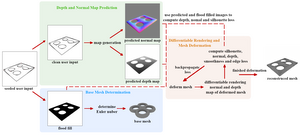Information
- Publication Type: Master Thesis
- Workgroup(s)/Project(s):
- Date: March 2023
- Date (Start): November 2022
- Date (End): 3. March 2023
- Second Supervisor: Clemens Havas (Department Creative Technologies, University of Applied Sciences Salzburg, Salzburg, Austria)
- Diploma Examination: 3. May 2023
- Note: Thesis created in cooperation with Department Creative Technologies, University of Applied Sciences Salzburg, Salzburg, Austria
- Open Access: yes
- First Supervisor: Philipp Erler
- Keywords: deep learning, single-view model generation, topology, differentiable rendering, 2.5d intermediate representation
Abstract
Deriving 3D models from sketches has been a relevant research topic for years now, mainly due to its potential to simplify the realization of ideas and drafts for certain professions like artists, engineers and designers. With the raise of neural networks, new methods start to form utilizing the learning capability of those networks. One such method is the application of differentiable rendering, where a base mesh is deformed until the difference between the differentiable renderings and the target image is reasonably small. However, those target images, e.g., normal or depth maps, are not inherently available to the system, since the only input is a sketch. Therefore, intermediate representations predicted from the sketch need to be generated, that provide the required information.The aim of this thesis is to provide a an end-to-end framework that reconstructs 3d models from 2d sketches using intermediate depth and normal representations and differentiable rendering. In addition to that, the topology of the sketch is determined and a respective base mesh is used for the mesh deformation. By comparing this setup to an established network as well as conducting an ablation study to reveal the effects the improvements have, the system and its limitations are evaluated. This will determine if the proposed optimisations facilitate input generalisability beyond class/object restrictions and improve mesh quality.
Additional Files and Images
Additional images and videos
 Method:
General system overview. From a seeded user sketch, the silhouette image, the normal and depth maps are translated and a base mesh is determined. Using those, a differentiable renderer is used in order to predict a 3d model.
Method:
General system overview. From a seeded user sketch, the silhouette image, the normal and depth maps are translated and a base mesh is determined. Using those, a differentiable renderer is used in order to predict a 3d model.
Additional files
 Thesis:
Master's Thesis by Kerstin Hofer: Sketch to 3d Model
Thesis:
Master's Thesis by Kerstin Hofer: Sketch to 3d Model
Weblinks
- Source Code
Repository on Github
BibTeX
@mastersthesis{hofer_kerstin-2023-sketch2model,
title = "Sketch to 3d-Model using Deep Learning and Differentiable
Rendering",
author = "Kerstin Hofer (Department Creative Technologies, University
of Applied Sciences Salzburg, Salzburg, Austria)",
year = "2023",
abstract = "Deriving 3D models from sketches has been a relevant
research topic for years now, mainly due to its potential to
simplify the realization of ideas and drafts for certain
professions like artists, engineers and designers. With the
raise of neural networks, new methods start to form
utilizing the learning capability of those networks. One
such method is the application of differentiable rendering,
where a base mesh is deformed until the difference between
the differentiable renderings and the target image is
reasonably small. However, those target images, e.g., normal
or depth maps, are not inherently available to the system,
since the only input is a sketch. Therefore, intermediate
representations predicted from the sketch need to be
generated, that provide the required information. The aim
of this thesis is to provide a an end-to-end framework that
reconstructs 3d models from 2d sketches using intermediate
depth and normal representations and differentiable
rendering. In addition to that, the topology of the sketch
is determined and a respective base mesh is used for the
mesh deformation. By comparing this setup to an established
network as well as conducting an ablation study to reveal
the effects the improvements have, the system and its
limitations are evaluated. This will determine if the
proposed optimisations facilitate input generalisability
beyond class/object restrictions and improve mesh quality.",
month = mar,
note = "Thesis created in cooperation with Department Creative
Technologies, University of Applied Sciences Salzburg,
Salzburg, Austria",
address = "Favoritenstrasse 9-11/E193-02, A-1040 Vienna, Austria",
school = "Research Unit of Computer Graphics, Institute of Visual
Computing and Human-Centered Technology, Faculty of
Informatics, TU Wien",
keywords = "deep learning, single-view model generation, topology,
differentiable rendering, 2.5d intermediate representation",
URL = "https://www.cg.tuwien.ac.at/research/publications/2023/hofer_kerstin-2023-sketch2model/",
}

 Method
Method Thesis
Thesis